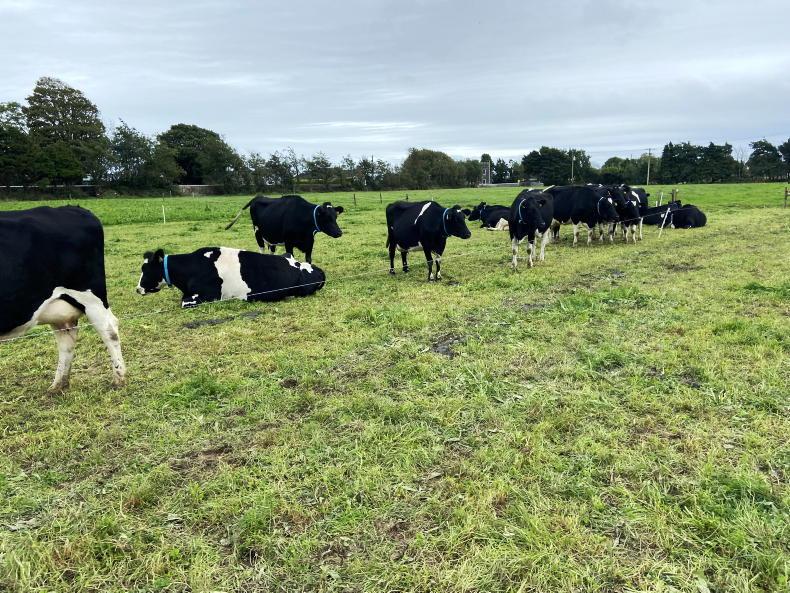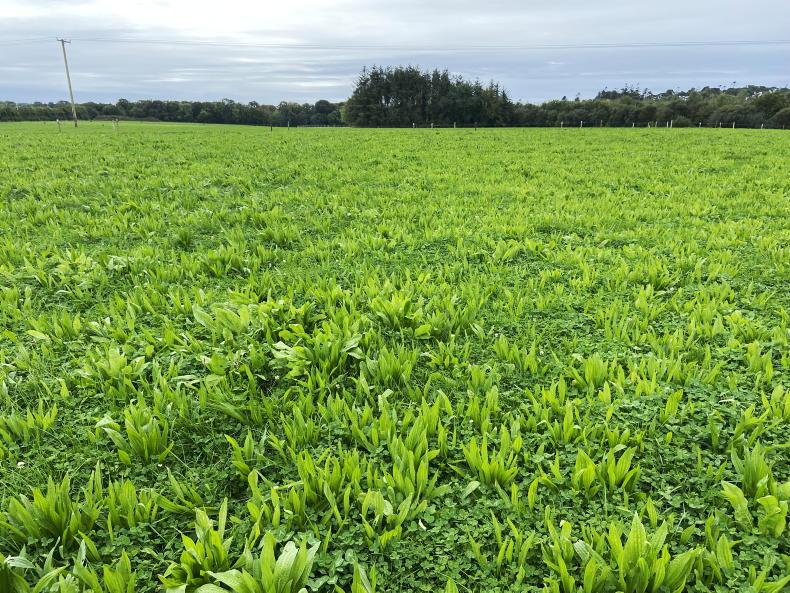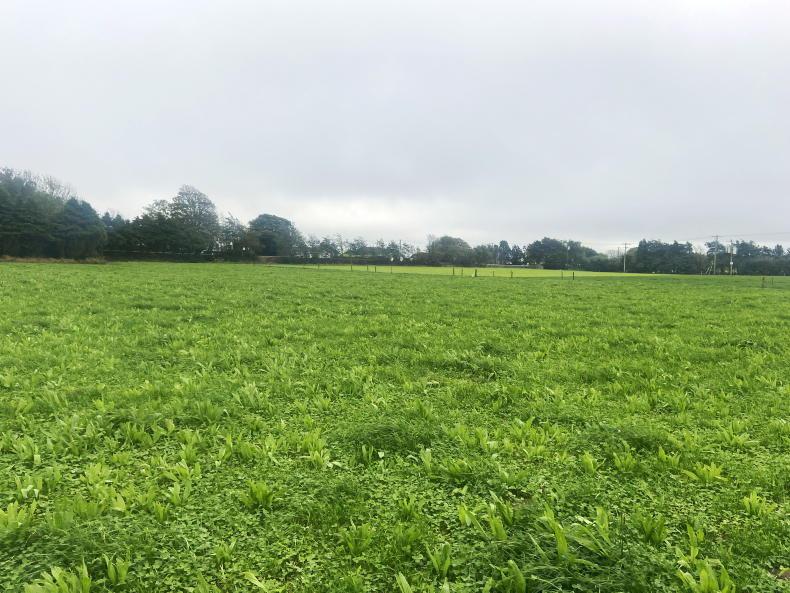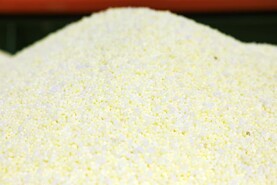Over the last couple of years, the interest in and popularity of multispecies swards has soared, albeit from a starting point of zero.
In last week’s budget, it was announced that special funding would be available for the establishment of multispecies swards on Irish farms.
The Irish Farmers Journal has tracked the progress of the new sward type over the last few years from research at UCD, Teagasc and farmer experience.
When it comes to Irish dairy systems research on multispecies swards (MSS), Teagasc is running two trials; one at Johnstown Castle and the other at Curtins Farm in Moorepark. I have got the opportunity to visit the Johnstown Castle trial twice over the last two weeks, both times with discussion groups.
Aidan Lawless from Teagasc is running the Johnstown Castle dairy unit along with researchers John Finn and Joe Patton.

Cows grazing multispecies swards two weeks ago at Johnstown Castle (1b).
There are 40 cows on the MSS trial, with 20 grazing multispecies swards containing red and white clover, plantain, chicory, perennial ryegrass and timothy.
The other 20 are grazing grass and clover swards. The stocking rate on both treatments is 2.6 cows/ha, the cows are all spring calving and the average EBI is high at €180. All cows are Holstein Friesian.
The MSS was established at various times throughout 2019, so the youngest swards are in the ground two full years. The grass and clover swards were established in 2019 and 2020 and some over-sowing was done this summer also to increase the clover content in these swards, something which Aidan says has been hit and miss.

Pre-grazing yield of multispecies swards at Johnstown Castle two weeks ago (2a).
There are differences in fertiliser nitrogen application rates across the two treatments. In 2020, the MSS swards received 82kgN/ha and this year they received just 64kgN/ha and Aidan says the swards never looked hungry all year.
A higher rate of nitrogen is being applied to the grass and clover swards. In 2020, these swards received 234kgN/ha but this year, it dropped to 155kgN/ha.
Aidan says the higher rate of nitrogen is required because the clover content on these swards is not where they would like it to be and that nitrogen rates will fall when clover content increases.
In terms of pasture growth, there is very little difference between the two swards this year. However, in 2020, the MSS grew 13.9tDM/ha while the grass and clover swards grew 1.1t more at 15tDM/ha.

Post grazing residual of multispecies swards this week (2b).
There was a big difference in nitrogen in 2020 though, with the grass and clover swards getting 152kgN/ha more chemical nitrogen. It could be said that the response to that extra nitrogen in terms of extra pasture grown was poor.
The gap has narrowed considerably this year. By the end of September, the MSS had grown 12.8tDM/ha and the grass and clover swards were identical, despite the fact that they received an extra 91kgN/ha.
On milk yield, last year both treatments produced identical milk solids at 535kg MS/cow each. However, the cows grazing the MSS did receive an extra 57kg of meal per cow with a total of 847kg meal fed per cow compared to 790kg of meal per cow for the cows grazing grass and clover.
“Most of the extra meal was fed in spring, due to lower than target opening grass covers and slower spring growth on the multispecies swards. We are definitely finding that they are slower to grow in the spring, but to be fair they really take off from about St Patrick’s Day onwards,” Aidan says.

Aidan Lawless (centre) is dairy farm manager at Johnstown Castle.
Up to the end of September this year, there was again no difference in yield per cow, with both groups having produced 450kg MS/cow each. The MSS cows have eaten more meal, with an extra 41kg meal/cow fed to date at 654kg of meal per cow. The grass and clover group of cows have been fed 613kg of meal so far this year.
When cows are milking, they are either grazing multispecies swards or grazing silage produced from MSS. There was an insufficient amount of silage produced last year in the MSS treatment, so additional grass silage had to be brought in and this was fed during the dry period.
In 2021 the multispecies swards have grown the same level of pasture and cows grazing them have produced the same level of milk solids as the grass and clover treatment but the MSS have only received 64kgN/ha.
By any metric, this is an incredibly positive result. The question on both the researchers’ and visiting farmers’ lips was will this trend continue?
“In many ways, this trial is just beginning now,” Aidan says.

David Wall checks the root of a chicory plant.
“We are already after seeing a big drop off in chicory content in the sward, but plantain is holding very well and the clover content is excellent. If we can repeat this over the next five or six years it’ll be a no-brainer. Even if we end up in a few years with a good grass and clover sward and very little other species that won’t be a bad outcome either,” he says.
The worry some people have is that if they die out, the space that was occupied by chicory, plantain and red clover could be left bare and unproductive, or taken over by weeds such as docks.
The MSS at Johnstown Castle does look great at present after two full years. John Finn, the Teagasc researcher who specialises in multispecies, says the swards are performing as expected and he thinks plantain will persist quite well.
Multispecies trial at Johnstown Castle has been running for 2020 and 2021 comparing multispecies with grass and clover swards on milking cows. The multispecies are performing well. This year, they have grown the same amount of pasture as the grass and clover swards but with just 64kgN/ha compared to 155kgN/ha on the grass and clover swards. Milk solids production is the same across the treatments.
Over the last couple of years, the interest in and popularity of multispecies swards has soared, albeit from a starting point of zero.
In last week’s budget, it was announced that special funding would be available for the establishment of multispecies swards on Irish farms.
The Irish Farmers Journal has tracked the progress of the new sward type over the last few years from research at UCD, Teagasc and farmer experience.
When it comes to Irish dairy systems research on multispecies swards (MSS), Teagasc is running two trials; one at Johnstown Castle and the other at Curtins Farm in Moorepark. I have got the opportunity to visit the Johnstown Castle trial twice over the last two weeks, both times with discussion groups.
Aidan Lawless from Teagasc is running the Johnstown Castle dairy unit along with researchers John Finn and Joe Patton.

Cows grazing multispecies swards two weeks ago at Johnstown Castle (1b).
There are 40 cows on the MSS trial, with 20 grazing multispecies swards containing red and white clover, plantain, chicory, perennial ryegrass and timothy.
The other 20 are grazing grass and clover swards. The stocking rate on both treatments is 2.6 cows/ha, the cows are all spring calving and the average EBI is high at €180. All cows are Holstein Friesian.
The MSS was established at various times throughout 2019, so the youngest swards are in the ground two full years. The grass and clover swards were established in 2019 and 2020 and some over-sowing was done this summer also to increase the clover content in these swards, something which Aidan says has been hit and miss.

Pre-grazing yield of multispecies swards at Johnstown Castle two weeks ago (2a).
There are differences in fertiliser nitrogen application rates across the two treatments. In 2020, the MSS swards received 82kgN/ha and this year they received just 64kgN/ha and Aidan says the swards never looked hungry all year.
A higher rate of nitrogen is being applied to the grass and clover swards. In 2020, these swards received 234kgN/ha but this year, it dropped to 155kgN/ha.
Aidan says the higher rate of nitrogen is required because the clover content on these swards is not where they would like it to be and that nitrogen rates will fall when clover content increases.
In terms of pasture growth, there is very little difference between the two swards this year. However, in 2020, the MSS grew 13.9tDM/ha while the grass and clover swards grew 1.1t more at 15tDM/ha.

Post grazing residual of multispecies swards this week (2b).
There was a big difference in nitrogen in 2020 though, with the grass and clover swards getting 152kgN/ha more chemical nitrogen. It could be said that the response to that extra nitrogen in terms of extra pasture grown was poor.
The gap has narrowed considerably this year. By the end of September, the MSS had grown 12.8tDM/ha and the grass and clover swards were identical, despite the fact that they received an extra 91kgN/ha.
On milk yield, last year both treatments produced identical milk solids at 535kg MS/cow each. However, the cows grazing the MSS did receive an extra 57kg of meal per cow with a total of 847kg meal fed per cow compared to 790kg of meal per cow for the cows grazing grass and clover.
“Most of the extra meal was fed in spring, due to lower than target opening grass covers and slower spring growth on the multispecies swards. We are definitely finding that they are slower to grow in the spring, but to be fair they really take off from about St Patrick’s Day onwards,” Aidan says.

Aidan Lawless (centre) is dairy farm manager at Johnstown Castle.
Up to the end of September this year, there was again no difference in yield per cow, with both groups having produced 450kg MS/cow each. The MSS cows have eaten more meal, with an extra 41kg meal/cow fed to date at 654kg of meal per cow. The grass and clover group of cows have been fed 613kg of meal so far this year.
When cows are milking, they are either grazing multispecies swards or grazing silage produced from MSS. There was an insufficient amount of silage produced last year in the MSS treatment, so additional grass silage had to be brought in and this was fed during the dry period.
In 2021 the multispecies swards have grown the same level of pasture and cows grazing them have produced the same level of milk solids as the grass and clover treatment but the MSS have only received 64kgN/ha.
By any metric, this is an incredibly positive result. The question on both the researchers’ and visiting farmers’ lips was will this trend continue?
“In many ways, this trial is just beginning now,” Aidan says.

David Wall checks the root of a chicory plant.
“We are already after seeing a big drop off in chicory content in the sward, but plantain is holding very well and the clover content is excellent. If we can repeat this over the next five or six years it’ll be a no-brainer. Even if we end up in a few years with a good grass and clover sward and very little other species that won’t be a bad outcome either,” he says.
The worry some people have is that if they die out, the space that was occupied by chicory, plantain and red clover could be left bare and unproductive, or taken over by weeds such as docks.
The MSS at Johnstown Castle does look great at present after two full years. John Finn, the Teagasc researcher who specialises in multispecies, says the swards are performing as expected and he thinks plantain will persist quite well.
Multispecies trial at Johnstown Castle has been running for 2020 and 2021 comparing multispecies with grass and clover swards on milking cows. The multispecies are performing well. This year, they have grown the same amount of pasture as the grass and clover swards but with just 64kgN/ha compared to 155kgN/ha on the grass and clover swards. Milk solids production is the same across the treatments. 










 This is a subscriber-only article
This is a subscriber-only article










SHARING OPTIONS: